Abstract
Algebraic effects are a long-studied programming language construct allowing the implementation of complex control flow in a structured way. With OCaml 5, such features are finally available in a mainstream programming language, giving us a great opportunity to experiment with varied concurrency constructs implemented as simple libraries. In this article, we explore how to implement concurrency features such as futures and active objects using algebraic effects, both in theory and in practice. On the practical side, we present a library of active objects implemented in OCaml, with futures, cooperative scheduling of active objects, and thread-level parallelism. On the theoretical side, we formalise the compilation of a future calculus that models our library into an effect calculus similar to the primitives available in OCaml; we then prove the correctness of the compilation scheme.
Access this chapter
Tax calculation will be finalised at checkout
Purchases are for personal use only
Notes
- 1.
In our implementation we choose to adopt the Actor terminology instead of active objects because we believe actors are better known in the functional programming community.
- 2.
For this purpose, we use PPX, a specific hook that allow to extend OCaml with new lightweight syntax extensions.
- 3.
In the future, we hope to turn asynchronous calls in a
 into delegation automatically.
into delegation automatically. - 4.
Already in [6], the authors prevented forward from appearing inside a closure.
- 5.
 denotes the reflexive transitive closure of the relation
denotes the reflexive transitive closure of the relation
 .
. - 6.
A few substitutions have occurred inside poll by definition of \(C_c\). We omit them here not to clutter the proof.
- 7.
Resp. \(\sigma _1(\ell _{threads})[f_2] = \mathbb {C}\left( \lambda () . ((\lambda x. C[x]) ~e)\right) \).
- 8.
Resp.
 and \(e_2=\mathbb {C}\left( \lambda () . ((\lambda x. C[x]) ~e)\right) \).
and \(e_2=\mathbb {C}\left( \lambda () . ((\lambda x. C[x]) ~e)\right) \). - 9.
Resp. with two steps of beta-reductions.
References
Baker Jr., H.G., Hewitt, C.: The incremental garbage collection of processes. In: Proceedings Symposium on Artificial Intelligence and Programming Languages, New York, NY, USA, pp. 55–59 (1977)
Bauer, A., Pretnar, M.: Programming with algebraic effects and handlers. J. Log. Algebraic Methods Program. 84(1), 108–123 (2015). https://doi.org/10.1016/j.jlamp.2014.02.001
de Boer, F., et al.: A survey of active object languages. ACM Comput. Surv. 50(5), 76:1–76:39 (2017). Article 76
Caromel, D., Henrio, L., Serpette, B.: Asynchronous and deterministic objects. In: Proceedings of the 31st ACM SIGPLAN-SIGACT Symposium on Principles of Programming Languages, pp. 123–134. ACM Press (2004)
Chappe, N., Henrio, L., Maillé, A., Moy, M., Renaud, H.: An optimised flow for futures: from theory to practice. CoRR abs/2107.07298 (2021). https://arxiv.org/abs/2107.07298
Fernandez-Reyes, K., Clarke, D., Castegren, E., Vo, H.P.: Forward to a promising future. In: Di Marzo Serugendo, G., Loreti, M. (eds.) COORDINATION 2018. LNCS, vol. 10852, pp. 162–180. Springer, Cham (2018). https://doi.org/10.1007/978-3-319-92408-3_7
Fernandez-Reyes, K., Clarke, D., Henrio, L., Johnsen, E.B., Wrigstad, T.: Godot: all the benefits of implicit and explicit futures. In: Donaldson, A.F. (ed.) 33rd European Conference on Object-Oriented Programming (ECOOP 2019). Leibniz International Proceedings in Informatics (LIPIcs), vol. 134, pp. 2:1–2:28. Schloss Dagstuhl-Leibniz-Zentrum fuer Informatik, Dagstuhl (2019). https://drops.dagstuhl.de/opus/volltexte/2019/10794. Distinguished artefact
Graf, S., Sifakis, J.: Readiness semantics for regular processes with silent actions. In: Ottmann, T. (ed.) ICALP 1987. LNCS, vol. 267, pp. 115–125. Springer, Heidelberg (1987). https://doi.org/10.1007/3-540-18088-5_10
Halstead, R.H., Jr.: MULTILISP: a language for concurrent symbolic computation. ACM Trans. Program. Lang. Syst. (TOPLAS) 7(4), 501–538 (1985)
Henrio, L.: Data-flow explicit futures. Research report, I3S, Université Côte d’Azur (2018). https://hal.archives-ouvertes.fr/hal-01758734
Henrio, L., Johnsen, E.B., Pun, V.K.I.: Active objects with deterministic behaviour. In: Dongol, B., Troubitsyna, E. (eds.) IFM 2020. LNCS, vol. 12546, pp. 181–198. Springer, Cham (2020). https://doi.org/10.1007/978-3-030-63461-2_10
Hillerström, D., Lindley, S.: Shallow effect handlers. In: Ryu, S. (ed.) APLAS 2018. LNCS, vol. 11275, pp. 415–435. Springer, Cham (2018). https://doi.org/10.1007/978-3-030-02768-1_22
Johnsen, E.B., Blanchette, J.C., Kyas, M., Owe, O.: Intra-object versus inter-object: concurrency and reasoning in Creol. In: Proceedings of the 2nd International Workshop on Harnessing Theories for Tool Support in Software (TTSS 2008). Electronic Notes in Theoretical Computer Science, vol. 243, pp. 89–103. Elsevier (2009)
Johnsen, E.B., Hähnle, R., Schäfer, J., Schlatte, R., Steffen, M.: ABS: a core language for abstract behavioral specification. In: Aichernig, B.K., de Boer, F.S., Bonsangue, M.M. (eds.) FMCO 2010. LNCS, vol. 6957, pp. 142–164. Springer, Heidelberg (2011). https://doi.org/10.1007/978-3-642-25271-6_8
Leonard, T., et al.: Eio 1.0 - effects-based IO for OCaml 5. OCaml Workshop (2023)
Leroy, X.: Formal certification of a compiler back-end, or: programming a compiler with a proof assistant. In: 33rd ACM Symposium on Principles of Programming Languages, pp. 42–54. ACM Press (2006). https://xavierleroy.org/publi/compiler-certif.pdf
Liskov, B., Shrira, L.: Promises: linguistic support for efficient asynchronous procedure calls in distributed systems. In: PLDI 1988, pp. 260–267. Association for Computing Machinery, New York (1988). https://doi.org/10.1145/53990.54016
Niehren, J., Schwinghammer, J., Smolka, G.: A concurrent lambda calculus with futures. Theor. Comput. Sci. 364(3), 338–356 (2006)
Sieczkowski, F., Pyzik, M., Biernacki, D.: A general fine-grained reduction theory for effect handlers. Proc. ACM Program. Lang. 7(ICFP) (2023). https://doi.org/10.1145/3607848
Sivaramakrishnan, K.C.: https://github.com/kayceesrk/ocaml5-tutorial. Accessed 30 May 2023
Sivaramakrishnan, K.C., et al.: Retrofitting parallelism onto OCaml. Proc. ACM Program. Lang. 4(ICFP), 113:1–113:30 (2020). https://doi.org/10.1145/3408995
Sivaramakrishnan, K.C., Dolan, S., White, L., Kelly, T., Jaffer, S., Madhavapeddy, A.: Retrofitting effect handlers onto OCaml. In: Freund, S.N., Yahav, E. (eds.) PLDI 2021: 42nd ACM SIGPLAN International Conference on Programming Language Design and Implementation, Virtual Event, Canada, 20–25 June 2021, pp. 206–221. ACM (2021). https://doi.org/10.1145/3453483.3454039
Taura, K., Matsuoka, S., Yonezawa, A.: ABCL/f: a future-based polymorphic typed concurrent object-oriented language - its design and implementation. In: Proceedings of the DIMACS Workshop on Specification of Parallel Algorithms, pp. 275–292. American Mathematical Society (1994)
Vouillon, J.: LWT: a cooperative thread library. In: Sumii, E. (ed.) Proceedings of the ACM Workshop on ML, 2008, Victoria, BC, Canada, 21 September 2008, pp. 3–12. ACM (2008). https://doi.org/10.1145/1411304.1411307
Author information
Authors and Affiliations
Corresponding author
Editor information
Editors and Affiliations
A Proof of the Bisimulation Theorem (Theorem 2)
A Proof of the Bisimulation Theorem (Theorem 2)
A proof of bisimulation involves two simulation proofs for the same relation. We detail the proof for the first direction: the behaviour of the compiled program is one of the behaviours of the original one. This direction is more complex because of the middle-step semantics and is also more important as it states that the behaviour of the compiled program is a valid one. The other direction is done very similarly with the same arguments as the ones used in the first direction. It however has a different structure as the SOS semantics provides more different cases (but the proof below often needs to distinguish cases according to the current state of the configuration, leading to a similar set of cases overall). We omit the other direction.
Consider
 , and
, and
 . Let i be the thread identifier of the thread involved in the reduction
. Let i be the thread identifier of the thread involved in the reduction
 (in case of spawn i is the thread that performs the spawn).
(in case of spawn i is the thread that performs the spawn).
We have
 and
and
 for some \(Q_1\) and \(Q'_1\). Additionally,
for some \(Q_1\) and \(Q'_1\). Additionally,
 and
and
 .
.
We do a case analysis on the rule used to prove the \(\text {R}_i\) relation; two cases are possible:
-
Continue:

In this case, the top level of continue is a handle thanks to the context \(C_c\).
 can result from three possible rules (modulo a seq rule at the configuration level and a \(\lambda \)-calculus context rule to reach the reducible statement):
can result from three possible rules (modulo a seq rule at the configuration level and a \(\lambda \)-calculus context rule to reach the reducible statement):-
HANDLE-RETURN
 must be of the form
must be of the form
 (and is inside a handle because of \(C_c\)).
(and is inside a handle because of \(C_c\)).We have
 . Its first visible reduction rule must be:
. Its first visible reduction rule must be: 
Where:
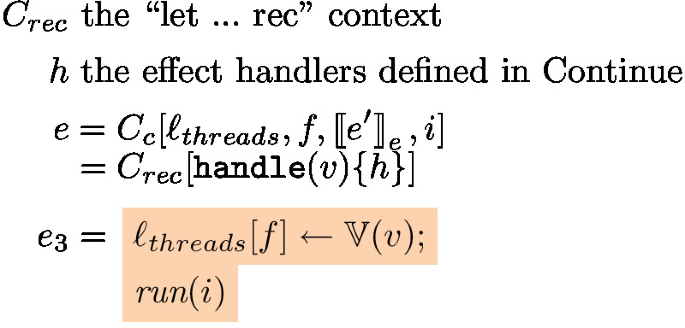
The hidden rules then update the appropriate task in the store and start the run function. Overall, we obtain:

Where

Since \(e= C_{rec}[\texttt {handle}{(v)}\{h\}]\), by case analysis on the compilation rules, we must have the source expression \(e' = v'\) be a Fut value with
 . Then we have:
. Then we have: 
We then need to establish that the new future map and stores are in relation, i.e., \(\sigma _2, \ell _{threads} \text {R}_e \sigma '_1, F_1\!\left[ f\mapsto v'\right] \).
We recall the env rule below:
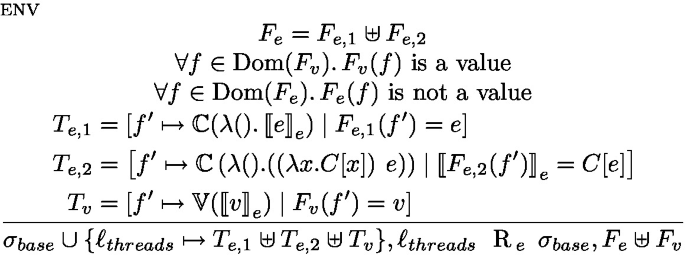
By inversion on
 , we obtain three maps \(T_{e,1} \uplus T_{e,2} \uplus T_v\) that ensure the relation. We extend \(T_v\) so that \(T_v[f]\mapsto \mathbb {V}(v)\) to obtain the relation.
, we obtain three maps \(T_{e,1} \uplus T_{e,2} \uplus T_v\) that ensure the relation. We extend \(T_v\) so that \(T_v[f]\mapsto \mathbb {V}(v)\) to obtain the relation.Recall that
 ; this is sufficient to conclude that
; this is sufficient to conclude that 
-
HANDLE-STEP
 must be of the form
must be of the form
 where
where
 can only be reduced by a \(\lambda \)-calculus reduction.
can only be reduced by a \(\lambda \)-calculus reduction.We have
 . Its first visible reduction rule must be:
. Its first visible reduction rule must be: 
Where:

The translation leave \(\lambda \)-calculus terms unchanged, without any hiding, thus there are no follow up hidden rules.
Overall, we obtain:

We know that \(\sigma _1, \ell _{threads} ~\text {R}_e~ \sigma '_1, F_1\). By definition, this means that \(\sigma _1 = \sigma '_1 \cup \{ \ell _{threads} \mapsto T \}\) for some map T. By definition of the translation, \(\ell _{threads}\) is not accessible by user code, and thus left unchanged by the reduction on
 . As such, we have:
. As such, we have: 
By case analysis on the translation and the \(\lambda \)-calculus reduction rules, \(e'\) must be reduced by the same \(\lambda \)-calculus reduction rule than
 . Thus:
. Thus: 
This case analysis and by determinism of our \(\lambda \)-calculus, we have
 . We also have \(\sigma _2, \ell _{threads} \text {R}_e \sigma '_2, F_1\).
. We also have \(\sigma _2, \ell _{threads} \text {R}_e \sigma '_2, F_1\).This is sufficient to conclude that

-
HANDLE-EFFECT
 must be of the form
must be of the form
 (and is inside a handle because of \(C_c\)). We distinguish by the effect captured:
(and is inside a handle because of \(C_c\)). We distinguish by the effect captured:-
\({\boldsymbol{Async}}({\boldsymbol{job}},t')\). We have
 . Its first visible reduction rule must be:
. Its first visible reduction rule must be: 
Where:
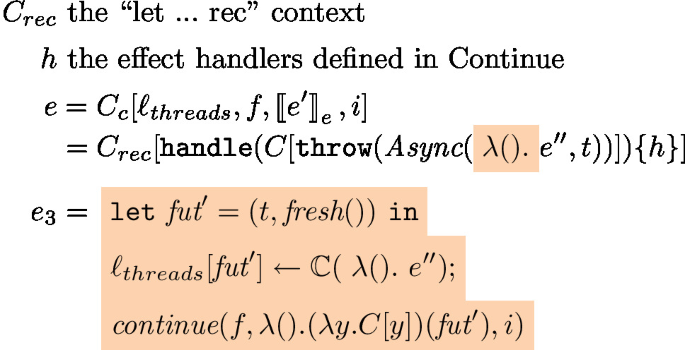
By definition of the translation, and because the reduction is possible, the arguments of the Async effect must be a thunk task, and its second argument must be a thread identifier (it can be an expression but this one is entirely evaluated before triggering the effect). This as some consequences on the considered Fut configuration, e.g. \(e'\) is of the form \(\texttt {AsyncAt}(e_0,t)\). Additionally, t is the same on both side as thread identifiers are preserved by the translation (this can be proven by case analysis on the definition of \(\text {R}_i\)).
The hidden rules apply then update the suspended tasks in the store and start the continue function. The last hidden reduction rule is the beta-reduction that de-thunks the continuation \( \lambda ().(\lambda y.C[y])(\textit{fut}')\) inside the handler of continue and puts \(\textit{fut}'\) back into the invocation context.
Overall, we obtain:

Where

Since
 , by case analysis on the compilation rules, we must have the source expression
, by case analysis on the compilation rules, we must have the source expression
 where
where
 and
and
 by Lemma 1. Note also that the set of future identifiers are the same in the Fut program and in its translation, and thus \(\textit{fut}' = (t,\textit{fresh}())\) is a fresh future in the Fut configuration. Then we have:
by Lemma 1. Note also that the set of future identifiers are the same in the Fut program and in its translation, and thus \(\textit{fut}' = (t,\textit{fresh}())\) is a fresh future in the Fut configuration. Then we have: 
We then need to establish that the new future map and stores are in relation, i.e., \(\sigma _2, \ell _{threads} \text {R}_e \sigma '_1, F_1\!\left[ \textit{fut}'\mapsto e'_1\right] \).
We recall the env rule below:
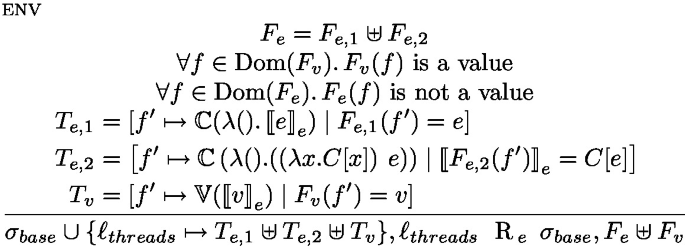
By inversion on \(\sigma _1,\ell _{threads} ~\text {R}_{e}~ \sigma _1',F_1\), we obtain tree maps \(T_{e,1} \uplus T_{e,2} \uplus T_v\) that ensure the relation. We then extend \(T_{e,1}\) so that
 to obtain the relation.
to obtain the relation.This is sufficient to conclude that

-
\({\boldsymbol{Get}}(f')\). We have
 . Its first visible reduction rule must be:
. Its first visible reduction rule must be: 
WhereFootnote 6:
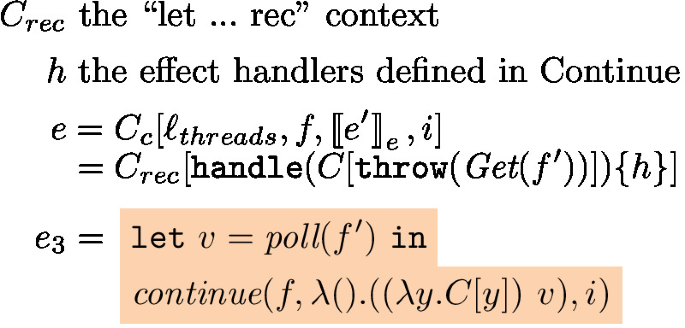
The argument of the Get effect must be a future reference that is totally evaluated for the rule to succeed. If it is not a future the evaluation of poll fails. If it is not fully evaluated, the reduction should first occur inside the argument of the Get effect.
Details on Poll Reductions. At this point, we look at hidden reductions, which must start in the body of poll. If the future is unresolved, poll loops forever and the medium step reduction diverges. This means either that the future never resolves, and this divergence in Eff simulates a deadlock in Fut; or that we could make reductions in other threads to resolve the deadlock. In the second case, the semantics for Eff would interleave loops in poll and reduction in other threads. Such interleaving is equivalent to triggering the Get event at the end, with a single loop in poll. The current theorem only consider this last interleaving. Overall, if there is a medium step reduction it means that the future is resolved.
In this case, the future has been resolved, and, by bisimilarity on the stores (\(\text {R}_e\)) we have \(F_1(f')=v\) and \(\sigma _1(\ell _{threads})[f']=v\) for some v. We obtain after a couple of steps of beta-reduction:

Since \(e= C_{rec}[\texttt {handle}{(C[\texttt {throw}({\textit{Get}(f'))}]}){h}]\), by case analysis on the compilation rules, we have
 where
where
 by Lemma 1. Then we have:
by Lemma 1. Then we have: 
This is sufficient to conclude that

-
Await\((f')\) . The case when the awaited future is resolved is similar to the case of the Get effect just above. We only detail the proof in case the future is still unresolved.
We have
 . Its first visible reduction rule must be:
. Its first visible reduction rule must be: 
Where:

Like in the Get case, the argument of the Await effect must be a future reference that is totally evaluated for the rule to succeed.
When the future is unresolved, \(\ell _{threads}[f']\) is not a value (it is not mapped or mapped to a \(\mathbb {C}{}\)). By definition of \(\texttt {R}_e\) we necessarily have: \(\not \exists v.\, (f' \mapsto v)\in F_1 \). Then a few hidden beta reduction steps lead to the following configuration:

Where

Since \(e= C_{rec}[\texttt {handle}{(C[\texttt {throw}({\textit{Await}(f'))}]}){h}]\), by case analysis on the compilation rules, we have
 where
where
 by Lemma 1. Thus on the Fut side, we have:
by Lemma 1. Thus on the Fut side, we have: 
We easily obtain that
 by expanding the environment \(T_{e,2}\) in the env rule.
by expanding the environment \(T_{e,2}\) in the env rule.With the arguments above and the case run of
 we conclude:
we conclude: 
-
\({\boldsymbol{Spawn}}()\). We have
 . Its first visible reduction rule must be:
. Its first visible reduction rule must be: 
With: \(C_{rec}\) the “let ... rec” context of the continue handler inside \(C_c\), h the effect handlers defined in Continue, additionally:

The first hidden rule applied is

Where \(e_2= C_2[\texttt {spawn}({\textit{run}})]\). This is followed by steps of beta reduction to reduce the \(\texttt{let}\ t' =\ldots \) construct, trigger continue, pass the associated \(\textit{tid}\) and de-thunk the \(\lambda ().\lambda y.C[y](\textit{tid})\) inside continue. We obtain the following configuration

Finally, by a step of beta reduction in the thread \(\textit{tid}\) we obtain the right evaluation context \(C_r\)

This configuration is not reducible by a hidden transition. Thus

By case analysis on the terms involved in
 we have
we have
 where
where
 by Lemma 1. We then have:
by Lemma 1. We then have: 
Note that by definition of
 the set of used thread identifiers is the same in both configurations, wo we can take the same fresh \(\textit{tid}\). Note also that the store and the future map are unchanged. Comparing thread by thread, we can directly apply rule run and rule cont for the two processes \(\textit{tid}\) and i, which leads to the conclusion:
the set of used thread identifiers is the same in both configurations, wo we can take the same fresh \(\textit{tid}\). Note also that the store and the future map are unchanged. Comparing thread by thread, we can directly apply rule run and rule cont for the two processes \(\textit{tid}\) and i, which leads to the conclusion: 
-
-
-
Run:

The only first applicable rule is the pop operation reduction that picks a new available thread:

Note that pop ensures that \(f_2\) is of the form \(f_2=(i, \textit{lf})\). Using only reductions in the thread i and such that:
 Footnote 7 by definition of \(\text {R}_i\) and
Footnote 7 by definition of \(\text {R}_i\) and
 Footnote 8 by definition of pop. Note that the last step of reduction is inside continue and de-thunks the new task (
Footnote 8 by definition of pop. Note that the last step of reduction is inside continue and de-thunks the new task (
 )Footnote 9. We additionally have:
)Footnote 9. We additionally have: 
From the points above, we obtain (with \(f_2=(i, \textit{lf})\)):

Note that
 by construction of the equivalence on stores (Fig. 16). Finally (the equivalence on the store can be trivially checked):
by construction of the equivalence on stores (Fig. 16). Finally (the equivalence on the store can be trivially checked): 
This immediately concludes by adding the other threads (in \(Q_1\) and \(Q'_1\)) and obtaining the
 relation on the obtained configurations. \(\square \)
relation on the obtained configurations. \(\square \)
Rights and permissions
Copyright information
© 2024 The Author(s), under exclusive license to Springer Nature Switzerland AG
About this chapter
Cite this chapter
Andrieux, M., Henrio, L., Radanne, G. (2024). Active Objects Based on Algebraic Effects. In: de Boer, F., Damiani, F., Hähnle, R., Broch Johnsen, E., Kamburjan, E. (eds) Active Object Languages: Current Research Trends. Lecture Notes in Computer Science, vol 14360. Springer, Cham. https://doi.org/10.1007/978-3-031-51060-1_1
Download citation
DOI: https://doi.org/10.1007/978-3-031-51060-1_1
Published:
Publisher Name: Springer, Cham
Print ISBN: 978-3-031-51059-5
Online ISBN: 978-3-031-51060-1
eBook Packages: Computer ScienceComputer Science (R0)


 into delegation automatically.
into delegation automatically. denotes the reflexive transitive closure of the relation
denotes the reflexive transitive closure of the relation
 .
. and
and 
 can result from three possible rules (modulo a
can result from three possible rules (modulo a  must be of the form
must be of the form
 (and is inside a handle because of
(and is inside a handle because of  . Its first visible reduction rule must be:
. Its first visible reduction rule must be: 



 . Then we have:
. Then we have: 

 , we obtain three maps
, we obtain three maps  ; this is sufficient to conclude that
; this is sufficient to conclude that 
 must be of the form
must be of the form
 where
where
 can only be reduced by a
can only be reduced by a  . Its first visible reduction rule must be:
. Its first visible reduction rule must be: 


 . As such, we have:
. As such, we have: 
 . Thus:
. Thus: 
 . We also have
. We also have 
 must be of the form
must be of the form
 (and is inside a handle because of
(and is inside a handle because of  . Its first visible reduction rule must be:
. Its first visible reduction rule must be: 



 , by case analysis on the compilation rules, we must have the source expression
, by case analysis on the compilation rules, we must have the source expression
 where
where
 and
and
 by Lemma
by Lemma 

 to obtain the relation.
to obtain the relation.
 . Its first visible reduction rule must be:
. Its first visible reduction rule must be: 


 where
where
 by Lemma
by Lemma 

 . Its first visible reduction rule must be:
. Its first visible reduction rule must be: 



 where
where
 by Lemma
by Lemma 
 by expanding the environment
by expanding the environment  we conclude:
we conclude: 
 . Its first visible reduction rule must be:
. Its first visible reduction rule must be: 





 we have
we have
 where
where
 by Lemma
by Lemma 
 the set of used thread identifiers is the same in both configurations, wo we can take the same fresh
the set of used thread identifiers is the same in both configurations, wo we can take the same fresh 




 )
)

 by construction of the equivalence on stores (Fig.
by construction of the equivalence on stores (Fig. 
 relation on the obtained configurations.
relation on the obtained configurations.